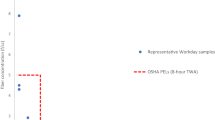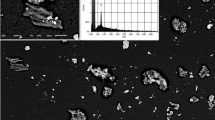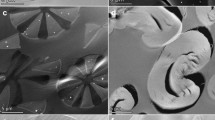Abstract
Over the past few years, a question has arisen about the degree of exposure to airborne asbestos associated with the application, cleanup, and tear-out of glues and mastics used between 1940 and the present. These liquid products were used either to adhere insulation to pipes and boilers or to cover the insulation so as to protect it. In this study, four asbestos-containing products, a coating, two mastics, and an adhesive, which were representative of the various classes of products that have been used historically, were tested to determine the airborne concentration of asbestos fibers released during five different activities (application, spill cleanup, sanding, removal, and sweep cleaning). Each activity was performed for 30 min (often in triplicate). Personal (n=172) and area (n=280) air samples were collected during the tests, and each was analyzed for total fiber concentrations using phase contrast microscopy (PCM), and for asbestos fiber count using transmission electron microscopy (TEM). A measurable concentration of asbestos fibers was detected in six of the 452 samples collected (0.0017–0.0184 fibers/ml). The observed asbestos fibers counts for each product were similar to background. Only one asbestos fiber was detected in an indoor background sample; no asbestos fibers were identified in any of the outdoor background samples. The (raw) PCM-total fiber concentrations were adjusted based on TEM analyses that reported fraction of asbestos fibers (to derive a PCM-asbestos concentration) and by the fraction of the 8-h workday that a worker spends performing the activity (to derive a calculated TWA). For the coatings, mastics, and adhesives evaluated in the present study, the calculated TWAs using hypothetical work scenarios were well below the current Occupational Safety and Health Administration (OSHA) Permissible Exposure Limit (PEL) of 0.1 fibers/ml. The calculated TWAs ranged from 0.03 to 0.009 fibers/ml. The actual concentration of airborne asbestos due to these products is almost certainly much less than the TWAs, and may be so low as to not be measurable. These results support the historical view that these products, over the past 50 years, did not pose an occupational health hazard under foreseeable uses.
This is a preview of subscription content, access via your institution
Access options
Subscribe to this journal
Receive 6 print issues and online access
$259.00 per year
only $43.17 per issue
Buy this article
- Purchase on Springer Link
- Instant access to full article PDF
Prices may be subject to local taxes which are calculated during checkout


Similar content being viewed by others
References
American Society of Heating, Refrigerating andAir-Conditioning Engineers (ASHRAE). Ventilation for acceptable indoor air quality. American National Standards Institute (ANSI)/ASHRAE Standard 62-2001, 2001.
American Society of Testing Materials (ASTM). Standard Terminology of Adhesives. D907-89 Annual Book of ASTM Standards. ASTM, Philadelphia, PA, 1989.
Brackett K.A., Clark P.J., and Powers T.J. TEM observations of airborne asbestos structures during the removal of vinyl asbestos tiles and mastic adhesive. Environ Choices Tech Suppl 1992, July/August 15–20 Volume 1(1).
Brinson H.F., Dostal C.A., Woods M.S., Ronke A.W., Henry S.D., Daquila J.L., and O'Keefe K.L. Engineered Materials Handbook Volume 3 Adhesives and Sealants. ASM International, Materials Park, OH, 1990.
Code of Federal Regulations (CFR). 29 Labor. Part 1926, Subpart Z. 29 CFR 1926.1101. Office of the Federal Register, National Archives and Records Administration July 1, 1995.
First M.W., and Love D. Engineering control of asbestos. Am Ind Hyg J 1982: 43: 634–639.
Hodgson A.A. Alternative to Asbestos and Asbestos Products. Anjalena Publications: Berkshire, England, 1985, pp. 165–166.
Hyde H.J., Statement of Chairman Henry J. Hyde, Committee on the Judiciary, Hearing on H.R. 1283, Fairness in Asbestos Compensation Act of 1999. July 1, 1999.
Lange J.H. Airborne asbestos concentrations during abatement of floor tile and mastic: evaluation of two different containment systems and discussion of regulatory issues. Indoor Built Environ 2001: 10: 193–199.
Lange J.H., and Thomulka K.W. Air sampling during asbestos abatement of floor tile and mastic. Bull Environ Contamin Toxicol 2000a: 64: 497–501.
Lange J.H., and Thomulka K.W. An evaluation of personal airborne asbestos exposure measurements during abatement of dry wall and floor tile/mastic. Int J Environ Health Res 2000b: 10: 5–91.
Mobil Oil Corporation. Evaluation of asbestos release from chimney weatherproofing mastic during application and removal. Prepared by Arthur D. Little, 1992.
National Institute for Occupational Safety and Health (NIOSH). NIOSH Method 7400. Asbestos and other fibers by PCM. NIOSH Manual of Analytical Methods. 4th edn. August 15, 1994a.
National Institute for Occupational Safety and Health (NIOSH). NIOSH Method 7402. Asbestos by TEM. NIOSH Manual of Analytical Methods. 4th edn. August 15, 1994b.
National Roofing Contractors Association (NRCA). Objective data” demonstration for certain roofing materials and operations under OSHA's 1994 asbestos standard. 1994.
Occupational Safety and Health Administration (OSHA). Occupational safety and health standards, Standard for exposure to asbestos dust. Title 29-Labor, Chapter XVII. Part 1910. 37FR11318-11322 (June 7, 1972).
Occupational Safety and Health Administration (OSHA). Occupational exposure to asbestos; final rule. Federal Register 59:153 (10 August 1994), pp. 40964–41158.
Panek J.R., and Cook J.P. Construction Sealants and Adhesives. 3rd edn John Wiley and Sons: New York, 1991.
Selikoff I.J. Partnership for prevention: the insulation industry research program. Ind Med 1970: 39: 162–166.
Skidmore J.W., and Dufficy B.L. Environmental history of a factory producing friction material. Br J Ind Med 1983: 40: 8–12.
US Army Corps of Engineers (ACE). Floor tile and mastic removal project report. November, 1992.
US Environmental Protection Agency (EPA). Evaluation of asbestos release from exterior masonry weatherproofing mastic during application and removal, with cover letter dated 122392. Arthur D. Little, Inc. EPA/OTS Doc#86-930000078,, 1992a.
US Environmental Protection Agency (EPA). Evaluation of asbestos releases from chimney weatherproofing mastic during application and removal, with cover letter dated 122392. Arthur D. Little, Inc. EPA/OTS Doc#86-930000079, 1992b.
US Environmental Protection Agency (EPA). 40CFR 763. Asbestos-containing material in school. July, 1999.
Wall Street Journal. Asbestos suits target makers of wine, cars, soups, soaps. April 12, 2000.
World Health Organization (WHO). Asbestos and other natural mineral fibres. Environmental Health Criteria 53. WHO, 1986.
Acknowledgements
Amchem Inc. and its successors, who originally manufactured these products in the 1950 s, 1960s, and 1970 s, funded this work. At least one of the authors has served as an expert in litigation involving these products. We acknowledge the exceptional material sciences work performed by Chris Scott, Bob Sage, Bob Cirrito, and Marie BenKinney, who reformulated the four products.
Author information
Authors and Affiliations
Corresponding author
Rights and permissions
About this article
Cite this article
Paustenbach, D., Sage, A., Bono, M. et al. Occupational exposure to airborne asbestos from coatings, mastics, and adhesives. J Expo Sci Environ Epidemiol 14, 234–244 (2004). https://doi.org/10.1038/sj.jea.7500320
Received:
Accepted:
Published:
Issue Date:
DOI: https://doi.org/10.1038/sj.jea.7500320
Keywords
This article is cited by
-
Personal and Static Sample Measurements of Asbestos Fibres During Two Abatement Projects
Bulletin of Environmental Contamination and Toxicology (2009)



